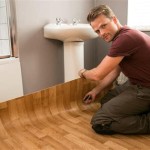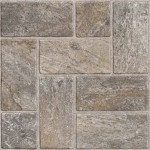Elevating Your Bathroom: Tile and Flooring Ideas for a Stylish and Functional Space
The bathroom, often considered a utilitarian space, is increasingly recognized as a personal sanctuary. Updating the tile and flooring is a transformative element in achieving both aesthetic appeal and practical functionality. Careful consideration of materials, design, and layout can convert an ordinary bathroom into a visually appealing and highly usable area within the home.
Understanding the Importance of Material Selection
The selection of materials for bathroom tile and flooring is paramount, as it directly impacts the longevity, maintenance requirements, and overall aesthetic of the space. Considerations must extend beyond visual appeal to encompass factors such as water resistance, slip resistance, and ease of cleaning.
Ceramic tile is a popular choice due to its versatility and affordability. It is available in a wide range of colors, patterns, and sizes, making it adaptable to various design styles. Ceramic tile is also relatively easy to clean and maintain, although it is more porous than porcelain and may require sealing to prevent water absorption.
Porcelain tile shares similarities with ceramic but is manufactured under higher pressures and temperatures, resulting in a denser and more durable material. Porcelain is virtually impervious to water, making it an ideal choice for bathroom floors and shower walls where moisture exposure is constant. Its increased density also makes it more resistant to scratches and stains.
Natural stone tiles, such as marble, granite, and slate, offer a luxurious and sophisticated aesthetic. Each stone has its own unique veining and texture, adding a distinctive character to the bathroom. However, natural stone requires more maintenance than ceramic or porcelain. It is porous and susceptible to staining, requiring regular sealing and specialized cleaning products. The cost of natural stone is also generally higher.
Luxury Vinyl Tile (LVT) and Luxury Vinyl Plank (LVP) have emerged as viable alternatives to traditional tile. These materials offer the look of wood or stone at a more affordable price point and with enhanced durability. LVT and LVP are waterproof, scratch-resistant, and comfortable underfoot, making them a practical choice for high-traffic bathrooms. Installation is typically easier than with ceramic or porcelain tile.
Glass tile provides a distinctive aesthetic with its reflective properties. It can be used to create intricate mosaics or as accent pieces to add visual interest. Glass tile is non-porous and easy to clean, but it can be more expensive than other tile options and may require specialized installation techniques.
When selecting materials, it is crucial to consider the slip resistance of the tile, especially for flooring. Tiles are rated with a slip resistance value, typically indicated by a Dynamic Coefficient of Friction (DCOF). A higher DCOF indicates greater slip resistance. Textured tiles or those with a matte finish generally offer better traction than smooth, glossy tiles.
Exploring Design Styles and Layouts
The design style and layout of the bathroom significantly influence the overall ambiance and functionality of the space. Harmonizing the tile and flooring with the existing fixtures and decor is essential to achieving a cohesive look.
For a modern aesthetic, clean lines, geometric patterns, and neutral color palettes are often favored. Large-format tiles can create a seamless and contemporary look, minimizing grout lines and enhancing the sense of spaciousness. Incorporating accent tiles in bold colors or interesting textures can add visual interest without overwhelming the overall design.
Traditional bathrooms often feature classic tile patterns, such as subway tiles or mosaic tiles. Warm color palettes, such as creams, beiges, and soft blues, create a timeless and inviting atmosphere. Natural stone tiles, such as marble or travertine, can enhance the sense of luxury and elegance. Wainscoting or decorative trim can further accentuate the traditional aesthetic.
Spa-inspired bathrooms emphasize tranquility and relaxation. Natural materials, such as wood-look tile or stone-look tile, are commonly used to create a connection with nature. Soft, muted colors, such as grays, greens, and blues, promote a sense of calm. Incorporating elements like a freestanding tub, a rainfall showerhead, and ambient lighting can further enhance the spa-like atmosphere.
For smaller bathrooms, maximizing space and creating the illusion of spaciousness is crucial. Light-colored tiles reflect light, making the room feel brighter and larger. Using large-format tiles can minimize grout lines and create a more seamless look. Installing a wall-mounted toilet and vanity can free up floor space and enhance the sense of openness.
The layout of the tile can also significantly impact the visual appeal of the bathroom. Running tiles vertically can create the illusion of height, while running them horizontally can make the room feel wider. Herringbone or chevron patterns can add visual interest and a sense of movement. Creating a focal point with a decorative tile accent wall can draw the eye and add personality to the space.
Grout color is another key element in the overall design. Matching the grout color to the tile color creates a seamless look, while contrasting grout can highlight the tile pattern. Dark grout is often preferred for high-traffic areas or for use with lighter-colored tiles, as it is less likely to show dirt and stains.
Practical Considerations for Installation and Maintenance
Proper installation and maintenance are crucial for ensuring the longevity and performance of bathroom tile and flooring. Hiring a qualified installer is essential for ensuring a professional and durable result. Proper surface preparation, including leveling the subfloor and applying a waterproof membrane, is critical for preventing moisture damage and ensuring that the tile adheres properly.
Grout sealing is an important step in protecting the grout from staining and water damage. Grout sealers penetrate the grout and create a barrier that repels water and dirt. It is recommended to reseal grout every one to two years, depending on the type of sealer used and the amount of traffic the bathroom receives.
Regular cleaning is essential for maintaining the appearance of bathroom tile and flooring. Avoid using harsh chemicals or abrasive cleaners, as these can damage the tile and grout. A mild detergent and water are typically sufficient for routine cleaning. For stubborn stains, a specialized tile cleaner or a mixture of baking soda and water can be used.
Preventative measures can also help to extend the life of bathroom tile and flooring. Using bath mats and shower mats can help to prevent slips and falls and protect the flooring from water damage. Promptly cleaning up spills and leaks can prevent staining and mildew growth. Regularly inspecting the grout for cracks or damage and repairing them promptly can prevent water from seeping into the subfloor.
When installing natural stone tile, it is important to use appropriate cleaning products specifically designed for natural stone. Acidic cleaners can damage natural stone, causing etching and discoloration. It is also important to avoid using abrasive cleaners, as these can scratch the surface of the stone. Regular sealing is essential for protecting natural stone from staining and water damage.
The choice of underlayment can also impact the performance of bathroom flooring. A proper underlayment can provide cushioning, reduce noise, and improve insulation. For concrete subfloors, a moisture barrier is essential to prevent moisture from seeping into the flooring. For wood subfloors, it is important to ensure that the subfloor is level and structurally sound before installing the flooring.
Heated flooring systems can add a touch of luxury and comfort to the bathroom. These systems can be installed under tile, stone, or vinyl flooring. Heated flooring provides even heat distribution and eliminates cold spots, creating a more comfortable and inviting space.
By carefully considering the material selection, design style, and practical considerations for installation and maintenance, homeowners can elevate their bathrooms with stylish and functional tile and flooring that will enhance their daily lives for years to come.

Bathroom Floor Tiles Hexagon More The Tile Shop

40 Free Shower Tile Ideas Tips For Choosing Why

Bathroom Flooring Ideas You Ll Love This Year Country Floors Of America Llc

Bathroom Tile Ideas The Home

Bathroom Flooring Options For Bathrooms Laminate Vs Tile Floors
Get Inspired With 15 Shower Design Ideas Floor Decor Blog

Bathroom Floor Tiles Hexagon More The Tile Shop

25 Bathroom Flooring Ideas Which One Do You Like The Most

Bathroom Tile Ideas The Home

Tile Flooring Inspiration








